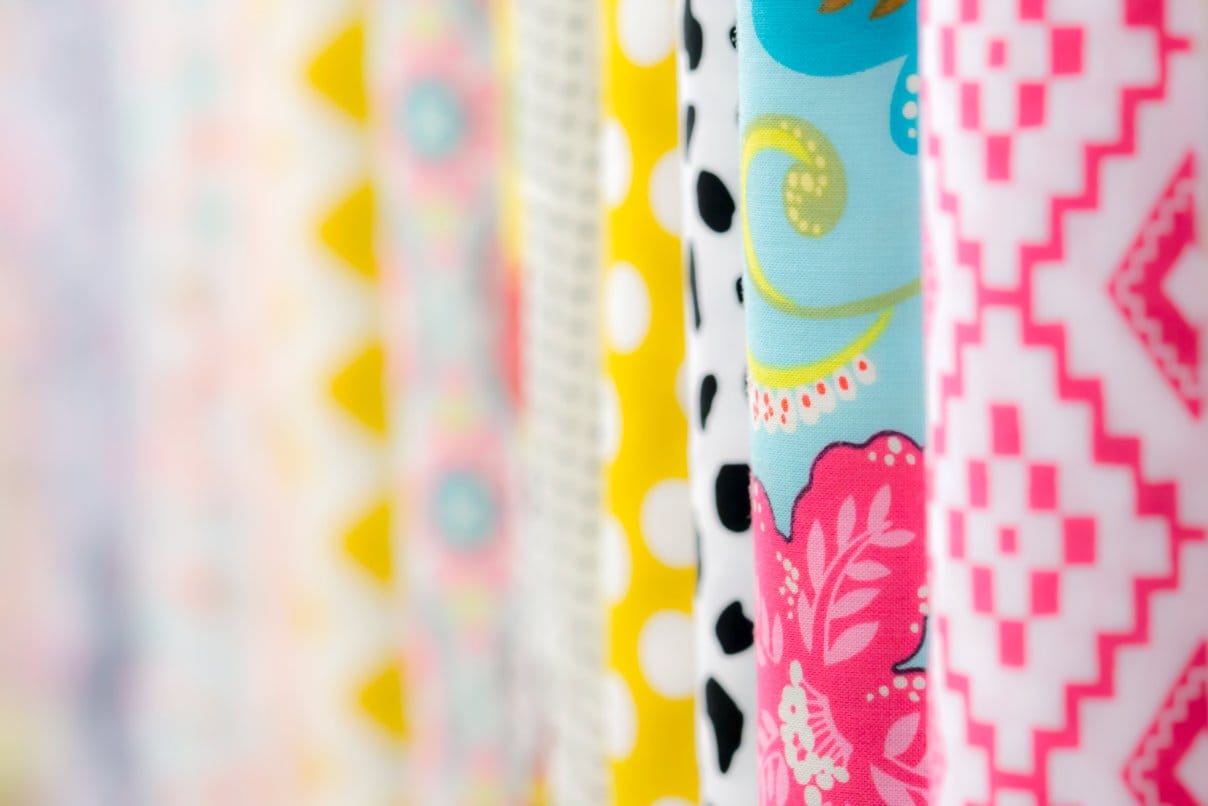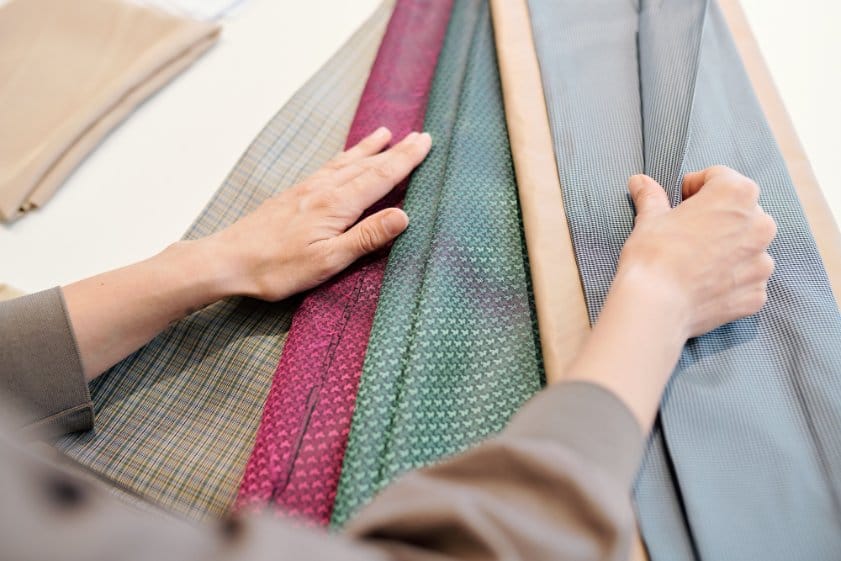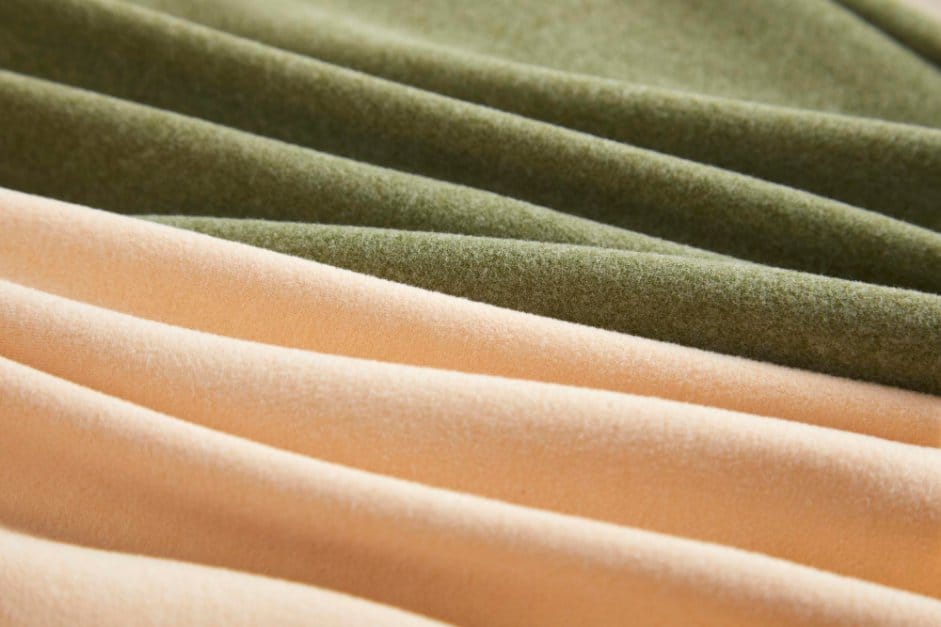Expert advice on choosing breathable materials that keep you cool all summer long
Key Takeaways
- Choose lightweight natural fibers like cotton, linen, and bamboo for maximum breathability
- Look for fabrics with GSM (grams per square meter) under 180 for hot weather
- Avoid 100% polyester and nylon in humid conditions as they trap heat and moisture
- Light colors reflect heat better than dark colors, helping you stay cooler
- Loose-fitting garments allow better air circulation than tight clothing
Choosing the right fabric for summer can make the difference between feeling miserable and staying comfortably cool all day long. When temperatures soar, your clothing becomes your first line of defense against heat and humidity. The right materials allow air to flow freely while pulling moisture away from your skin, keeping you dry and comfortable even on the hottest days.
Summer-friendly fabrics help regulate your body temperature naturally. They move with you, maintain their shape in humid conditions, and resist the clingy, sticky feeling that makes hot weather unbearable. Whether you’re building a professional wardrobe, planning vacation outfits, or just trying to survive another scorching summer, understanding fabric properties will transform how you feel in warm weather.
Table of Contents
- Essential Qualities of Summer Fabrics
- Natural Fabrics: Your Summer Allies
- Synthetic Fabrics and Modern Blends
- Specialty Summer Fabrics
- Understanding Fabric Blends
- Smart Fabric Choices for Different Situations
- Fabrics to Avoid in Summer
- Fabric Care and Maintenance
- Fabric Technology and Innovation
- Color and Pattern Considerations
- Regional Climate Adaptations
- Shopping and Wardrobe Building
- Frequently Asked Questions
Essential Qualities That Make Summer Fabrics Work
Good summer fabrics share specific qualities that help your body stay cool. Understanding these properties helps you identify the best materials for hot weather, whether you’re shopping for ready-made clothes or selecting fabric types for your own sewing projects. The fundamental difference between natural and synthetic fabrics becomes crucial when building a summer wardrobe.
Breathability and Air Flow
Breathable fabrics allow air to move freely through the material, creating natural ventilation that prevents heat from building up next to your skin. This airflow is crucial for temperature regulation and comfort.
When you hold quality summer fabric up to light, you should see small gaps in the weave. These tiny spaces create channels for air circulation. Loosely woven materials naturally provide better ventilation than tightly packed fibers.
The weight of fabric matters significantly. Light and airy materials feel more comfortable against your skin than dense, heavy ones. They create space between the fabric and your body, allowing heat to escape rather than getting trapped.
Fabric Weight Guide for Summer
- Ultra-light: 80-120 GSM – Perfect for hot, humid climates
- Light: 120-180 GSM – Ideal for most summer wear
- Medium: 180-250 GSM – Better for air-conditioned environments
- Heavy: 250+ GSM – Avoid for hot weather
Need help calculating fabric weight?
Use our Fabric Weight Calculator to determine the perfect GSM for your summer projects.
Moisture Management and Quick-Drying Properties
Your summer clothes need to handle sweat effectively. Good moisture-wicking fabrics pull perspiration away from your skin and spread it across the fabric surface where it can evaporate quickly.
This process prevents several uncomfortable problems including wet patches that show through clothing, fabric clinging to your body, extended dampness that feels unpleasant, and sweat stains that become permanent.
Natural fibers like cotton absorb moisture well but can take longer to dry completely. Modern synthetic blends often provide faster moisture control for very active situations, though they may trap odors more easily than natural materials.
Natural Fabrics: Your Summer Allies
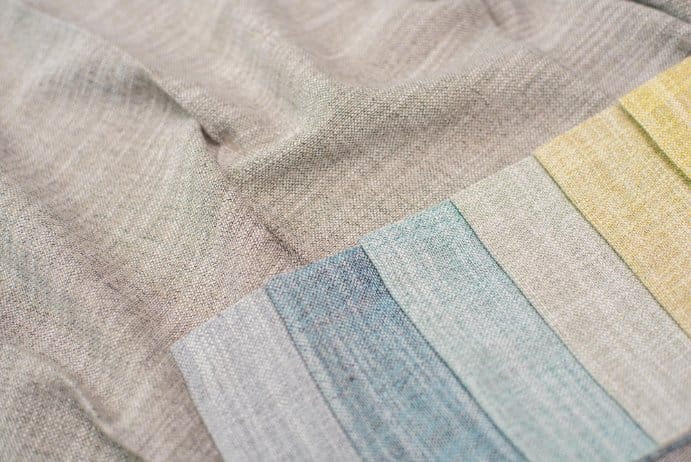
Natural fibers remain the gold standard for summer comfort. These materials come from plants and animals, making them both sustainable and highly effective at temperature regulation. They’ve been keeping people cool for thousands years, and modern processing has only improved their performance.
Cotton: The Classic Summer Choice
Cotton continues to be the most versatile summer fabric because of its excellent breathability and moisture-absorbing abilities. This natural fiber feels soft against your skin while allowing maximum airflow.
Why Cotton Works for Summer
- Absorbs up to 27 times its weight in water
- Gets softer with each wash
- Naturally hypoallergenic
- Easy to care for and maintain
Best Cotton Types for Hot Weather
Seersucker and Chambray: The puckered texture of seersucker creates air channels that lift fabric away from your skin. Chambray uses a lighter weave than traditional denim, making it breathable yet durable.
Cotton Poplin: This smooth, crisp fabric drapes well and resists wrinkles better than plain weave cotton, making it ideal for professional summer wear.
Cotton Voile and Lawn: These lightweight, semi-sheer fabrics are perfect for layering without overheating.
Jersey Knit: Stretchy and comfortable for casual wear, jersey allows maximum airflow while providing a flattering drape.
Muslin: This lightweight, plain-weave cotton has been used for centuries in hot climates. Its loose weave and soft feel make it excellent for summer clothing.
Expert Tip: Choose lightweight cotton weaves like jersey knit for t-shirts and casual wear. These softer varieties feel gentle against your skin and allow maximum airflow. The fabric’s natural fibers absorb sweat and let it evaporate quickly, helping regulate your body temperature on hot days.
Is Supima Cotton Good for Hot Weather?
Yes, Supima cotton is excellent for hot weather. This premium cotton variety features extra-long fibers that create a softer, more durable fabric with better moisture absorption than regular cotton. The longer fibers also result in a smoother surface that feels cooler against your skin.
However, Supima cotton does have some disadvantages. It costs significantly more than regular cotton (often 2-3 times the price), requires more careful washing to maintain its premium qualities, and can be harder to find in stores. Despite these drawbacks, many people find the superior comfort and longevity worth the investment.
Is 100% Cotton Good for Hot Weather?
Yes, 100% cotton is excellent for hot weather, especially in lightweight weaves. Cotton absorbs moisture well, feels soft against skin, and allows good airflow. However, linen and bamboo may feel cooler in extreme heat or high humidity. Choose cotton with GSM under 180 for best hot weather performance.
Is 100% Cotton Better Than Cotton Blends?
100% cotton is generally better for breathability and comfort in hot weather. Pure cotton absorbs moisture effectively and allows excellent airflow. However, cotton blends can offer practical advantages like reduced wrinkling, improved shape retention, and easier care.
The best choice depends on your priorities. If staying cool is your main concern, go with 100% cotton. If you need wrinkle resistance and easy care for travel or professional wear, a blend with a small amount of synthetic fiber (like 95% cotton, 5% spandex) can work well without sacrificing too much breathability.
What is the Coolest Cotton Fabric?
Cotton voile is the coolest cotton fabric. This ultra-lightweight, semi-sheer material has a loose weave that allows maximum airflow. Other cool cotton options include cotton lawn, cotton gauze, and seersucker. All have GSM under 120 and feel airy against the skin.
Can We Wear Muslin Fabric in Summer?
Yes, muslin fabric is excellent for summer. This lightweight, plain-weave cotton fabric is highly breathable and soft. Muslin has been used for centuries in hot climates because of its loose weave and comfortable feel. It’s perfect for casual summer clothing, lightweight scarves, and children’s wear.
| Cotton Type | Weight (GSM) | Best For | Breathability |
|---|---|---|---|
| Cotton Voile | 80-100 | Layering, scarves | Excellent |
| Cotton Lawn | 90-110 | Dresses, blouses | Excellent |
| Cotton Poplin | 120-150 | Shirts, professional wear | Very Good |
| Jersey Knit | 140-180 | T-shirts, casual wear | Very Good |
| Muslin | 100-130 | Casual clothing, children’s wear | Excellent |
For detailed cotton care instructions, visit our cotton care guide.
Linen: The Ultimate Hot Weather Fabric
What is the most breathable fabric for hot weather? Linen takes the top spot. Made from flax plant fibers, linen’s loose weave creates natural ventilation channels that keep air moving across your skin constantly.
Why Linen Excels in Summer
- Natural loose weave provides maximum airflow
- Gets softer and more comfortable with each wash
- Resistant to dirt and stains
- Dries faster than most natural fabrics
- Lasts for many years with proper care
The fabric’s structure naturally holds itself away from your body, creating air pockets that prevent clinging in humid weather. Fresh linen can feel stiff initially, but this actually helps keep the fabric from sticking to your skin when you sweat.
Is Linen Cooler Than Cotton?
Yes, linen is cooler than cotton in most situations. Linen’s loose weave allows more air circulation, and it wicks moisture away faster than cotton. The fabric also has a slightly rough texture that prevents it from clinging to sweaty skin, unlike smooth cotton which can stick when wet.
In scientific terms, linen fibers are hollow and can absorb up to 20% of their weight in moisture before feeling damp. This means you’ll feel drier in linen even when perspiring. Cotton absorbs more total moisture but takes longer to dry and can feel heavy when wet.
Does Linen Keep You Cool?
Absolutely. Linen is one of the most cooling fabrics available. Its natural structure allows heat to escape while permitting continuous airflow. The fabric doesn’t trap heat next to your skin like synthetic materials do. Many people report feeling 5-10 degrees cooler in linen compared to other fabrics.
Is Linen Better Than Cotton in Summer?
Linen is better than cotton for extremely hot weather due to superior breathability and quick-drying properties. However, cotton wins for everyday comfort and durability. Linen excels in dry heat, while cotton performs well in various hot weather conditions. Your best choice depends on your specific needs and climate.
Is Linen More Breathable Than Cotton?
Yes, linen is more breathable than cotton. Linen’s looser weave allows approximately 20% more airflow than cotton. The fabric also wicks moisture away faster and dries more quickly, making it feel cooler in hot weather. However, cotton is softer, more affordable, and easier to care for.
Compare linen vs cotton vs other fabrics side-by-side
Check out our Summer Fabric Comparison Tool to see detailed ratings for breathability, cost, and durability.
Linen Care Tips for Summer: Wash in cool water to prevent excessive shrinking. Line dry when possible to maintain fiber strength. Iron while slightly damp for best results. Store hanging to prevent deep wrinkles. Learn more in our complete linen care guide.
Silk: Luxurious Temperature Control
Pure silk offers natural temperature regulation that works in both hot and cool weather. The protein fibers are extremely thin and lightweight, making silk one of the most breathable natural materials available.
Is Silk Breathable in Hot Weather?
Yes, silk is highly breathable in hot weather. Despite common misconceptions, silk wicks moisture away from the body and allows air to circulate freely. The smooth surface reflects heat while its porous structure allows moisture to escape, keeping you feeling fresh even on warm days.
Is Silk Hot to Wear?
No, silk is not hot to wear in summer. Quality silk actually helps regulate body temperature by adapting to your environment. It feels cool to the touch initially and warms up gently without trapping heat. However, silk can show sweat stains more easily than other fabrics, so choose darker colors or printed patterns for very hot weather.
Is Silk for Summer or Winter?
Silk works for both summer and winter due to its exceptional temperature-regulating properties. In summer, it wicks away moisture and feels cool against the skin. In winter, it provides insulation while allowing breathability. This versatility makes silk an excellent year-round fabric choice.
Which is More Breathable: Cotton or Silk?
Cotton and silk have similar breathability levels, but they work differently. Cotton absorbs more moisture directly into the fibers (up to 27% of its weight), while silk wicks moisture away from the skin more quickly. Silk dries faster than cotton, making it feel less damp. For hot, humid conditions, silk’s quick-drying nature often makes it feel more comfortable.
Does Sweat Ruin Silk?
Sweat can damage silk if left untreated. The salt and acids in perspiration can weaken silk fibers and cause discoloration over time. To prevent damage, rinse silk garments after wearing in hot weather, never let sweat dry on the fabric, and wash promptly with a gentle detergent made for delicates. Avoid using regular detergent or fabric softener on silk.
What is the Disadvantage of Silk?
Silk’s main disadvantages include showing sweat stains easily, requiring careful hand washing or dry cleaning, higher cost compared to cotton or linen, vulnerability to damage from perspiration if not cleaned promptly, and being delicate and prone to snags. Despite these drawbacks, silk’s comfort and elegant appearance make it worthwhile for many people.
Silk Advantages
- Naturally temperature regulating
- Extremely lightweight and comfortable
- Smooth surface feels cool on skin
- Elegant drape and luxurious appearance
- Natural UV protection
Silk Disadvantages
- Shows sweat stains easily
- Requires careful hand washing
- More expensive than cotton or linen
- Can be damaged by perspiration
- Delicate and prone to snags
Is Mulberry Silk Real Silk?
Yes, mulberry silk is real silk and is actually the highest quality silk available. It comes from silkworms fed exclusively on mulberry leaves, producing longer, more uniform fibers than other silk types. Mulberry silk feels smoother, stronger, and more lustrous than wild silk varieties. For summer wear, it’s the best silk choice due to superior breathability and durability.
Is Muslin Silk Good for Summer?
Yes, muslin silk is very good for summer. This lightweight silk fabric combines silk’s natural temperature regulation with muslin’s loose, breathable weave. The result is an airy, elegant fabric perfect for hot weather. Muslin silk drapes beautifully and feels cooler than regular silk, making it ideal for summer dresses and flowing garments.
Is Silk or Satin More Breathable?
Silk is more breathable than satin. It’s important to note that satin is a weave type, not a fiber. Silk satin (satin weave made from silk fibers) is more breathable than polyester satin. If comparing silk charmeuse (a type of silk satin) to regular woven silk, the regular weave will be more breathable because the satin weave is tighter.
Best Silk Types for Summer
- Habotai: Lightweight and affordable
- Chiffon: Ultra-sheer and flowy
- Georgette: Crepe texture with good drape
- Silk jersey: Stretchy and comfortable
For detailed silk care instructions, visit our silk care guide.
Bamboo: Soft and Naturally Cooling
Bamboo fabric combines supreme softness with impressive moisture management. The fibers contain micro-gaps that enhance ventilation and moisture absorption, making it an excellent choice for people who tend to sweat heavily.
Is Bamboo Fabric Good for Summer?
Yes, bamboo fabric is excellent for summer. It absorbs 40% more water than cotton while drying faster, and its natural antibacterial properties reduce odors. The fabric feels cool to the touch and provides natural UV protection (UPF 50+). Many people find bamboo even more comfortable than cotton for hot, humid weather.
Bamboo Fabric Benefits
- Absorbs 40% more water than cotton
- Naturally antibacterial properties reduce odors
- UV protective qualities (UPF 50+)
- Biodegradable and environmentally friendly
- Incredibly soft texture
The material feels especially cool against your skin because it efficiently wicks away sweat and allows it to evaporate. The fiber structure creates natural ventilation that rivals linen for airflow.
Hemp: Durable and Sustainable
Hemp creates strong, long-lasting fabric that actually gets better with age. Its fibers are naturally hollow, creating pathways for heat to escape and air to circulate freely.
Hemp Advantages for Summer
- Blocks harmful UV rays naturally
- Resists bacterial growth and odors
- Becomes softer and more comfortable over time
- Uses minimal water and pesticides to grow
- Three times stronger than cotton
The fabric’s porous nature makes it highly breathable while its strength means your summer clothes will last through many seasons of wear.
Synthetic Fabrics and Modern Blends
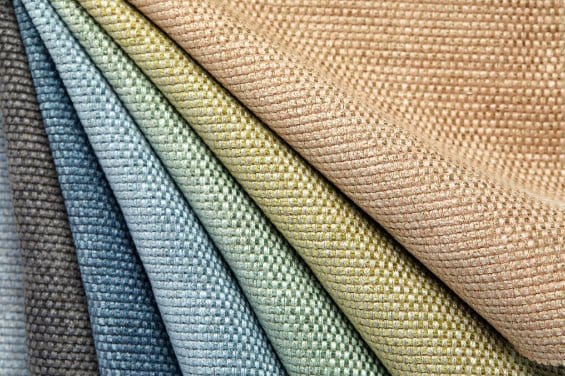
While natural fibers often perform best in summer, modern synthetic materials and blends offer unique advantages. Understanding when to choose these options helps you build a more versatile summer wardrobe. For a comprehensive understanding of different materials, see our guide on types of fabrics, both natural and synthetic.
Rayon and Viscose: Plant-Based Synthetics
Is viscose or cotton better for summer? Both have advantages, but viscose edges out cotton for moisture management. Rayon (including viscose) provides excellent breathability at a lower cost than pure natural fibers.
Is Viscose Good for Hot Weather?
Yes, viscose is very good for hot weather. It’s highly breathable and absorbs more moisture than cotton while drying faster. The fabric drapes beautifully and feels silky against the skin, making it comfortable in humid conditions. However, viscose loses some strength when wet and requires gentle care.
Is Viscose Hot to Wear in Summer?
No, viscose is not hot to wear in summer. It’s actually one of the cooler synthetic options available. The semi-synthetic fabric breathes well and wicks moisture effectively, making it suitable for hot, humid weather. Many summer dresses and blouses use viscose for its cooling properties and elegant drape.
Is Viscose Breathable?
Yes, viscose is very breathable. In fact, it’s more breathable than many other synthetic fabrics and comparable to cotton in terms of air permeability. The fabric allows air to flow through while managing moisture effectively, which is why it’s popular for summer clothing.
Is Rayon Better Than Cotton for Summer?
Rayon and cotton each have strengths for summer wear. Rayon drapes better, dries faster, and feels silkier, making it ideal for flowing dresses and blouses. Cotton is more durable, easier to care for, and better for active wear. For dressy occasions in hot weather, rayon often wins. For everyday comfort and longevity, cotton is the better choice.
Is Rayon or Viscose Cooler?
Rayon and viscose are essentially the same fabric (viscose is a type of rayon), so they have similar cooling properties. Both are semi-synthetic fabrics made from plant cellulose that breathe well and feel cool against the skin. Any difference in coolness comes from the specific weave or weight rather than the fiber type itself.
Is Viscose Better Than Cotton?
Viscose isn’t universally better than cotton, but it has advantages for certain uses. Viscose drapes more elegantly, absorbs moisture faster, and has a silkier feel. However, cotton is more durable, easier to wash, holds up better when wet, and lasts longer. Choose viscose for dressier summer pieces and cotton for everyday basics.
| Property | Viscose | Cotton |
|---|---|---|
| Breathability | Very Good | Excellent |
| Moisture Absorption | Excellent | Very Good |
| Drying Speed | Fast | Moderate |
| Durability | Fair | Very Good |
| Care Difficulty | Moderate | Easy |
| Cost | Lower | Moderate |
Expert Tip: Choose rayon blends with natural fibers for the best results. A cotton-rayon mix gives you durability while maintaining the soft drape rayon is known for.
Understanding Polyester in Summer
Is 100% polyester breathable? Not really. Pure polyester can make you uncomfortable in warm weather because it traps heat and moisture against your skin. However, modern polyester blends and treated polyester can work for specific summer situations. Understanding the complete polyester fabric guide helps you distinguish between different polyester types and their applications.
Does Polyester Fade in the Sun?
Polyester is actually one of the most sun-resistant fabrics available. It fades much less than natural fibers like cotton or linen when exposed to UV rays. This makes polyester a good choice for outdoor furniture and items that will spend lots of time in direct sunlight. However, this sun resistance doesn’t make up for its poor breathability in hot weather clothing.
When Polyester Works in Summer
- Athletic wear with moisture-wicking treatments
- Outdoor gear needing durability and UV protection
- Travel clothing that needs to be wrinkle-resistant
- Blend with 60% or less polyester content
What makes you sweat more, polyester or viscose? Polyester definitely makes you sweat more because it doesn’t absorb moisture or allow good airflow. Viscose performs much better for hot weather comfort. Learn more about cotton vs polyester for summer wear.
For proper care of polyester garments during hot weather, refer to our guide on washing and caring for 100% polyester to maintain their performance properties.
Tencel and Lyocell: Modern Performance
Is Tencel Cool to Wear?
Yes, Tencel is very cool to wear. This modern fabric made from wood pulp has excellent moisture management properties and feels cool to the touch. It absorbs 50% more moisture than cotton while maintaining breathability. Tencel is softer than cotton, drapes beautifully, and resists wrinkles, making it ideal for summer travel and professional wear.
Tencel also has environmental benefits, using a closed-loop production process that recycles water and solvents. For hot weather, it combines the best properties of natural and synthetic fabrics without the drawbacks of either.
Nylon: Limited Summer Applications
Which fabrics are best for summer? Nylon typically isn’t one of them. The fabric traps heat and moisture against your skin, making it uncomfortable for hot weather.
Is Nylon Breathable Like Cotton?
No, nylon is not breathable like cotton. Nylon is a synthetic fabric that doesn’t allow air to flow through as easily as natural fibers. While treated athletic nylon may have some moisture-wicking properties, it doesn’t compare to cotton’s natural breathability and comfort in hot weather.
Does Nylon Get Hot in the Summer?
Yes, nylon gets hot in summer because it traps heat next to your skin. The synthetic fibers don’t breathe well, and the fabric can feel clammy when you sweat. Nylon also tends to retain odors more than natural fabrics, making it a poor choice for hot weather unless specifically designed for athletic performance.
Does Nylon Trap Moisture?
Yes, nylon traps moisture against your skin. Unlike cotton or linen, which absorb moisture and allow it to evaporate, nylon holds moisture in place. This creates an uncomfortable, sticky feeling in hot weather. While some technical nylon fabrics have moisture-wicking treatments, plain nylon is one of the worst fabrics for summer comfort.
Is Nylon Too Hot for Summer?
Regular nylon is too hot for most summer wear. However, you might use nylon garments when you need high durability for outdoor activities, stretch recovery for athletic wear, water resistance for rain protection, or UV protection for extended sun exposure. Choose nylon items with mesh panels or ventilation features for better airflow when you must use this material.
Micromodal: Premium Comfort
Micromodal offers premium comfort for summer clothing. This semi-synthetic fabric feels incredibly soft and light on your skin while managing moisture efficiently.
Micromodal Benefits
- Softer than cotton and stays that way
- Wicks moisture away efficiently
- Resists shrinking and fading
- Maintains shape after repeated washing
- Naturally resistant to bacterial growth
Choose micromodal for underwear, t-shirts, lightweight dresses, and casual tops where comfort is the priority.
Specialty Summer Fabrics for Specific Needs
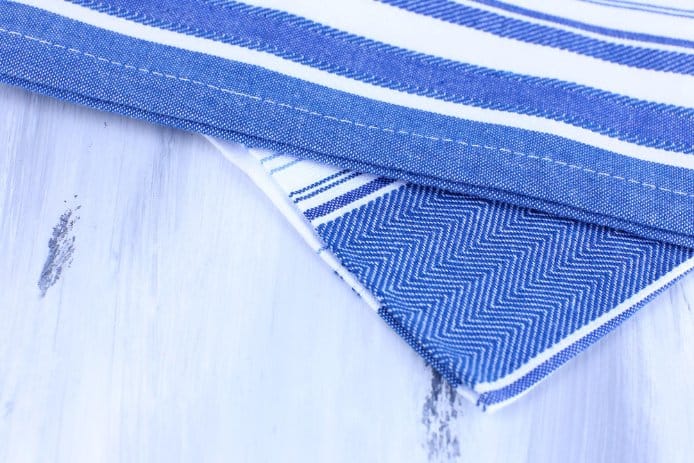
Several unique fabrics excel in particular summer situations. Understanding these specialty materials helps you choose the perfect fabric for specific activities and occasions.
Chambray: Denim’s Breathable Cousin
Chambray uses a plain weave construction that creates a lightweight, breathable fabric perfect for summer wear. Unlike traditional denim, chambray features a 1:1 weave ratio of colored and white threads, making it much more breathable than heavy denim.
This fabric feels soft against your skin and gets better with each wash. Chambray shirts work great for both casual and semi-formal summer occasions. The lightweight nature makes it ideal for layering without overheating.
Seersucker: Natural Air Conditioning
What is Seersucker Fabric?
Seersucker is a thin, puckered cotton fabric with a distinctive crinkled appearance created during the weaving process. The puckered sections stand away from smooth sections, creating natural air channels between the fabric and your skin. This unique structure makes seersucker one of the coolest fabrics for summer, especially in humid climates.
Seersucker Advantages
- No ironing required (wrinkles are intentional)
- Traditional patterns hide sweat marks
- Professional appearance for business casual
- Gets more comfortable with washing
- Classic American summer style
The fabric requires no ironing since its signature wrinkles are part of its charm. Seersucker suits and dresses remain popular choices for outdoor summer events and weddings.
Crepe Fabrics
Is Crepe Fabric Good for Summer?
Yes, crepe fabric is good for summer, especially for dressier occasions. The crinkled texture creates small air pockets similar to seersucker, allowing heat to escape. Crepe drapes beautifully and resists wrinkles, making it ideal for summer travel. However, crepe is less breathable than plain weave cotton or linen, so it works best in air-conditioned environments or for evening wear.
Poplin for Professional Wear
Is Poplin Good for Hot Weather?
Yes, poplin is good for hot weather, particularly for professional settings. This tightly woven cotton fabric has a smooth, crisp finish that looks polished while remaining breathable. Poplin is lighter than broadcloth but more substantial than voile, making it perfect for summer dress shirts and blouses. It resists wrinkles better than plain cotton, maintaining a professional appearance throughout the day.
Performance Fabrics: Technology Meets Comfort
Do cooling fabrics really work? Yes, modern performance fabrics use advanced technology to actively cool your body. These materials often incorporate phase change materials that absorb and release heat automatically, ceramic particles that reflect body heat away from skin, silver fibers that provide antimicrobial properties, and mesh construction that creates strategic ventilation zones.
What is the Best Material for Long Sleeves in Hot Weather?
Performance fabrics with UPF protection work best for long sleeves in hot weather. Look for lightweight synthetic blends specifically designed for sun protection that offer UPF 50+ sun protection, moisture-wicking properties, quick-dry capabilities, and lightweight, breathable construction. These fabrics protect your skin from harmful UV rays while keeping you cooler than exposed skin would be in direct sunlight.
Merino Wool: Summer’s Surprising Hero
Is Merino Wool Good for Hot Weather?
Yes, merino wool is surprisingly excellent for hot weather. While wool is famous for warmth, lightweight merino wool actually excels at temperature regulation in summer too. It pulls moisture away 30% faster than cotton, naturally resists odors even after multiple wears, regulates temperature automatically, feels soft and non-itchy against skin, and provides natural UV protection.
Look for lightweight merino wool with GSM under 150 for optimal summer comfort. Consider merino wool t-shirts and underwear for activities where you’ll sweat frequently.
Important: Not all wool is created equal for summer. Heavy winter wool will make you miserable in hot weather. Only lightweight merino wool (under 150 GSM) works well for warm weather.
Satin Considerations
Is Satin Fabric Good for Summer?
Satin is not ideal for hot summer weather. While the smooth surface feels cool initially, satin’s tight weave limits breathability. The fabric doesn’t absorb moisture well, so you may feel clammy when sweating. Satin works better for summer evening wear in air-conditioned environments than for daytime outdoor activities.
Is Satin a Cool Fabric?
Satin feels cool to the touch due to its smooth surface, but it’s not a cool fabric for temperature regulation. The weave is too tight to allow good airflow, and it doesn’t manage moisture effectively. If you love the look of satin for summer, choose silk satin over polyester satin for better breathability.
Understanding Fabric Blends for Summer
Fabric blends combine different fibers to balance performance, durability, and cost. Understanding how blends perform in summer helps you make smart shopping decisions.
Cotton-Polyester Blends
Is 50% Cotton 50% Polyester Good for Summer?
A 50/50 cotton-polyester blend is acceptable for summer but not ideal. This blend offers wrinkle resistance and durability but sacrifices some breathability. You’ll stay cooler in 100% cotton or a blend with higher cotton content. The 50/50 blend works better for cooler summer evenings or air-conditioned environments than for hot, humid days.
What are the Disadvantages of 50/50 Cotton Polyester?
The main disadvantages of 50/50 cotton-polyester blends include reduced breathability compared to pure cotton, tendency to trap body heat and moisture, increased likelihood of feeling clammy when sweating, greater odor retention than natural fibers, and less comfort in very hot, humid conditions. The blend also doesn’t improve much with age like pure cotton does.
Is 70% Cotton 30% Polyester Breathable?
Yes, 70/30 cotton-polyester is reasonably breathable and works well for summer. The higher cotton content provides good airflow while the polyester adds wrinkle resistance and shape retention. This blend offers a better balance than 50/50 for hot weather wear. Many people find 70/30 blends comfortable for everyday summer clothing.
Is 60% Cotton 40% Polyester Good?
A 60/40 cotton-polyester blend sits in the middle ground. It’s more breathable than 50/50 but less than 70/30. This blend works well for activewear and clothes that need extra durability. For maximum summer comfort, aim for at least 65% cotton in any blend.
Does 60% Cotton 40% Polyester Shrink?
A 60/40 blend shrinks less than 100% cotton but can still shrink slightly. The polyester content helps stabilize the fabric, reducing shrinkage to about 2-3% compared to cotton’s 5-7%. Always follow care instructions and wash in cool water to minimize shrinkage.
Is 65% Cotton 35% Polyester Good?
Yes, 65/35 cotton-polyester is a good compromise for summer wear. This ratio provides mostly cotton breathability while adding enough polyester for wrinkle resistance and durability. Many quality t-shirts and casual shirts use this blend because it offers comfort without excessive maintenance.
Is 60% Cotton 40% Polyester Good for Eczema?
A 60/40 blend may work for mild eczema, but 100% cotton is usually better. The polyester content can sometimes irritate sensitive skin because it doesn’t breathe as well and can trap heat and moisture. If you have eczema, choose 100% cotton or blends with at least 90% cotton. Always wash new clothes before wearing to remove manufacturing chemicals that might trigger reactions.
Is Polycotton Good for Summer?
Polycotton (a general term for cotton-polyester blends) can be okay for summer if the cotton content is high (above 60%). However, pure cotton performs better in very hot weather. Polycotton’s advantage is easier care and wrinkle resistance, making it practical for travel or professional settings where appearance matters.
Is Cotton Rich Good for Summer?
Yes, “cotton rich” fabrics (typically 80% or more cotton) are good for summer. These blends maintain most of cotton’s breathability while adding just enough synthetic fiber for improved shape retention and reduced wrinkling. Cotton rich fabrics offer nearly the same comfort as 100% cotton with added practical benefits.
| Blend Ratio | Breathability | Wrinkle Resistance | Best For | Summer Rating |
|---|---|---|---|---|
| 100% Cotton | Excellent | Poor | Maximum comfort | ★★★★★ |
| 95% Cotton, 5% Spandex | Excellent | Good | Fitted clothing | ★★★★★ |
| 70% Cotton, 30% Polyester | Good | Excellent | Easy care | ★★★★ |
| 60% Cotton, 40% Polyester | Fair | Excellent | Activewear | ★★★ |
| 50% Cotton, 50% Polyester | Fair | Excellent | Workwear | ★★ |
Elastane and Spandex Blends
Can I Wear Elastane in Summer?
Yes, you can wear elastane (also called spandex or Lycra) in summer, but only in small percentages. Most comfortable summer clothing contains 2-5% elastane blended with cotton or other breathable fibers. This small amount adds stretch and shape retention without significantly impacting breathability. Avoid fabrics with more than 10% elastane for hot weather.
Not sure which fabric blend is right for your needs?
Try our Interactive Fabric Selector Tool to find your perfect match based on your climate, activities, and preferences.
Smart Fabric Choices for Different Summer Situations
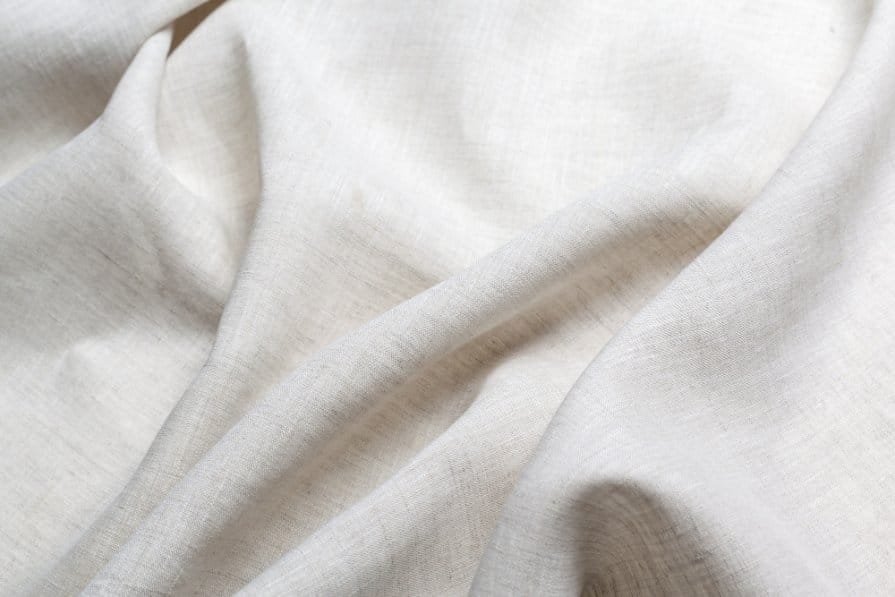
Different summer activities and climates require specific fabric strategies. Understanding how to match fabrics to situations helps you stay comfortable in any circumstance.
Hot and Humid Climate Strategies
What Material is Best for Hot and Humid?
For hot and humid climates, prioritize fabrics that manage moisture over pure breathability. Bamboo fabric is the best overall choice because it absorbs 40% more moisture than cotton while resisting odors. Linen blends (linen mixed with cotton or viscose), lightweight cotton jersey, and Tencel also perform excellently in humidity.
What Fabric is Suitable for Hot Weather?
Linen, lightweight cotton, bamboo, and Tencel are most suitable for hot weather. These fabrics combine breathability with moisture management. For extreme heat, linen offers the most cooling, while bamboo works best when humidity is high. Choose based on whether you’re dealing with dry heat or humid conditions.
What Fabrics Trap the Most Moisture?
Polyester, nylon, acrylic, and rubber-backed fabrics trap the most moisture. These synthetic materials don’t absorb sweat and prevent it from evaporating, creating a clammy feeling. Avoid these fabrics in hot, humid weather unless they have special moisture-wicking treatments designed for athletic use.
Best Fabric Choices for Humidity
- Bamboo fabric – Superior moisture absorption
- Linen blends – Pure linen plus cotton or viscose
- Lightweight cotton – Jersey knits and voile
- Tencel – Modern moisture-wicking properties
Dealing with Excessive Sweating
What Should I Wear If I Sweat Excessively?
If you sweat excessively, choose bamboo or merino wool for their antimicrobial properties, wear loose-fitting garments that don’t cling when wet, select dark colors and busy patterns that hide moisture, and layer moisture-wicking base layers under breathable outer garments. Avoid pure cotton for heavy sweating as it absorbs moisture but stays damp for a long time.
What is the Best Fabric for Wicking Sweat?
Merino wool is the best natural fabric for wicking sweat, pulling moisture away 30% faster than cotton while naturally resisting odors. Among synthetics, treated polyester with moisture-wicking technology performs well for athletic activities. Bamboo and Tencel also excel at sweat management, combining good absorption with quick drying.
What Fabric Does Not Show Armpit Sweat?
Dark colors (charcoal gray, navy, black), heather fabrics (marled textures), busy prints and patterns, and moisture-wicking athletic fabrics hide armpit sweat best. Textured fabrics like seersucker also camouflage wet spots better than smooth fabrics. Avoid light gray, which shows sweat worst of all colors.
What is the Best Fabric to Avoid Sweating?
While no fabric prevents sweating (which is a natural cooling mechanism), linen and bamboo reduce the discomfort of sweating. Linen dries quickly and doesn’t stick to skin when wet. Bamboo absorbs moisture efficiently and resists odor-causing bacteria. Both fabrics help you feel fresher even when sweating in hot conditions.
What Fabric Does Not Get Hot in the Sun?
Light-colored linen, cotton, and hemp do not get hot in the sun compared to synthetic fabrics. These natural fibers reflect heat rather than absorbing it, especially in white or pale shades. Fabrics with UPF ratings also help by blocking UV radiation before it converts to heat. Avoid dark colors and synthetic fabrics like polyester, which absorb and retain heat.
Professional Summer Dressing
What is the Best Fabric for Summer Dresses?
Cotton voile, linen, viscose, and bamboo are the best fabrics for summer dresses. These materials drape well, provide excellent breathability, and feel comfortable against the skin. For special occasions, lightweight silk or silk blends offer elegance with cooling properties.
Business-Appropriate Summer Fabrics
- Cotton poplin: Crisp appearance with good airflow
- Lightweight wool: Professional look with temperature regulation
- Silk blends: Elegant drape with cooling properties
- Tencel/Lyocell: Smooth finish that resists wrinkles
What is more breathable than cotton? Linen offers superior breathability, while bamboo provides better moisture management. For professional settings, lightweight wool gabardine or cotton-linen blends often work best.
Extreme Heat Conditions
What to Wear in 110 Degree Weather?
In extreme heat (110°F/43°C), wear loose-fitting linen or lightweight cotton in white or light colors that reflect heat, long sleeves made from UPF-rated fabric to protect skin from sun while staying cool, wide-brimmed hats and sunglasses, and moisture-wicking undergarments. Counterintuitively, covered skin often feels cooler than exposed skin in extreme heat because it prevents direct sun exposure while allowing airflow.
Which Fabric is Best for Extreme Summer?
Linen is the best fabric for extreme summer heat due to its superior breathability and quick-drying properties. For extreme heat with high humidity, bamboo fabric performs better. In desert climates with dry heat, lightweight cotton in loose weaves provides excellent protection and comfort.
What Fabric Can Withstand the Highest Heat?
For heat resistance in terms of durability (not comfort), aramid fibers like Kevlar and Nomex withstand the highest temperatures. However, for wearable comfort in hot weather, this question is about staying cool rather than heat resistance. Linen and lightweight cotton help you withstand hot weather best by promoting cooling through ventilation and moisture evaporation.
Travel and Vacation Fabrics
What Type of Clothes Should We Wear in Summer?
In summer, wear loose-fitting clothes in natural or breathable synthetic fabrics, lightweight materials like cotton, linen, bamboo, or viscose, light colors that reflect heat, and layers you can adjust for different temperatures throughout the day.
Travel-Friendly Summer Fabrics
- Merino wool – Odor-resistant for multiple wears
- Wrinkle-resistant cotton blends – Look neat without ironing
- Quick-dry synthetics – Easy to wash and dry in hotels
- Packable fabrics – Lightweight materials that don’t take up luggage space
Climate-Specific Strategies
Is It Better to Wear Tight or Loose Clothes in Humidity?
Loose clothes are much better in humidity. Fitted clothing traps moisture and heat against your skin, preventing evaporation that cools you down. Loose garments allow air to circulate around your body, facilitating sweat evaporation and keeping you cooler. Aim for at least 1-2 inches of space between fabric and skin in humid conditions.
What is the Most Cooling Breathable Fabric?
Linen is the most cooling and breathable fabric overall. Its loose weave allows maximum airflow while the hollow fibers draw heat away from your body. In scientific testing, people wearing linen report feeling 5-10 degrees cooler than those wearing other fabrics in the same conditions.
What is the Most Breathable Fabric for Sleeping?
Cotton and linen are the most breathable fabrics for sleeping in summer. Egyptian cotton with a high thread count provides softness and breathability. Bamboo sheets also work excellently for hot sleepers due to superior moisture-wicking. Avoid polyester or synthetic blend sheets in summer as they trap heat.
Fabrics to Avoid in Summer
Knowing which fabrics to avoid is just as important as knowing which ones to choose. Some materials will make hot weather unbearable, no matter how stylish they look.
Worst Performers in Hot Weather
Which Fabric to Avoid in Summer?
Avoid 100% polyester, heavy denim, nylon without moisture-wicking treatment, acrylic, thick cotton twill, non-breathable synthetic blends, leather and faux leather, fleece, velvet, and heavy wool in summer. These materials trap heat, don’t breathe well, or are too heavy for hot weather comfort.
What Fabric is Worst for Hot Humid Weather?
100% polyester is the worst fabric for hot, humid weather. It traps heat and moisture against your skin, prevents evaporation, and can feel like wearing a plastic bag. Other fabrics to avoid in humidity include heavy denim, nylon without moisture-wicking treatment, acrylic, and non-breathable synthetic blends.
Avoid These Fabrics in Summer:
- 100% Polyester – Traps heat and doesn’t breathe
- Heavy Denim – Too dense for proper airflow
- Thick Cotton Twill – Weight prevents cooling
- Non-breathable Synthetic Blends – Similar problems to polyester
- Leather and Faux Leather – No breathability, traps heat
- Fleece – Designed for insulation, not cooling
- Velvet – Dense pile traps heat
- Heavy Wool – Insulating properties work against you
- Acrylic – Sticks to body with zero breathability
Understanding Why Some Fabrics Fail
Fabrics fail in summer for specific reasons. Understanding why helps you avoid similar materials and make better choices.
Tight weave: Dense fabrics don’t allow air circulation. The tighter the weave, the less breathable the fabric becomes.
Synthetic composition: Most synthetic fibers don’t absorb moisture and prevent heat from escaping your body.
Heavy weight: Thick fabrics create insulation, which is the opposite of what you want in hot weather.
Dark colors: While not a fabric property, dark colors absorb heat rather than reflecting it, making you feel hotter regardless of the fabric type.
Fabric Care and Maintenance for Summer
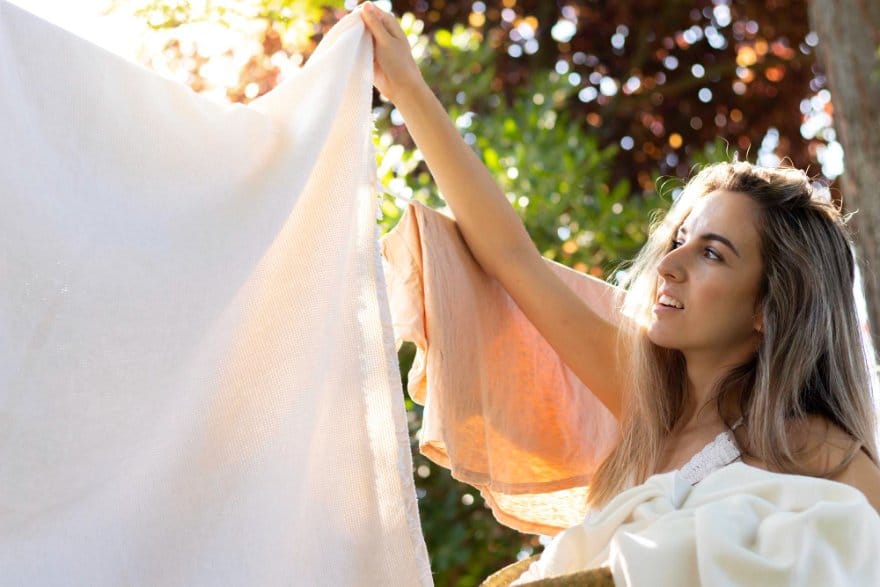
Proper care keeps summer fabrics performing at their best. Hot weather, frequent washing, and sun exposure can damage delicate materials if you’re not careful. Understanding how to wash and care for different fabrics becomes especially important during summer when frequent washing is necessary.
Washing Summer Fabrics
General Summer Fabric Care
- Wash in cool water to prevent shrinking
- Use gentle detergents to preserve fiber integrity
- Avoid overloading the machine for proper cleaning
- Pre-treat sweat stains immediately
- Line dry when possible to extend fabric life
Specific Care by Fabric Type
Cotton: Can handle regular washing, but line dry when possible to prevent shrinkage and preserve softness.
Linen: Wash in cool water and iron while damp for best results. Linen actually improves with washing.
Silk: Hand wash or use delicate cycle with silk-specific detergent. Never wring or twist silk fabrics.
Bamboo: Machine washable but avoid fabric softener, which can coat fibers and reduce absorbency.
Viscose: Gentle cycle only, reshape while damp to prevent distortion.
Denim: While heavy denim isn’t ideal for summer, lightweight denim and chambray can be washed less frequently and should be turned inside out to preserve color.
Wool: Lightweight merino wool should be hand washed in cool water or machine washed on gentle cycle. Never use hot water or agitation.
Expert Tip: Sweat contains salt and acids that can weaken natural fibers over time. Always rinse or wash summer clothes promptly after wearing in hot weather to extend their lifespan.
Storage and Organization
Summer Fabric Storage Tips
- Hang delicate items to prevent wrinkles
- Store in cool, dry places away from direct sunlight
- Use cedar blocks instead of mothballs for natural protection
- Rotate seasonal wardrobes to prevent fabric stress
Dealing with Common Summer Fabric Problems
Preventing and Treating Sweat Stains
- Apply antiperspirant at night for maximum effectiveness
- Pre-treat stains with enzyme-based cleaners
- Soak heavily stained items before washing
- Never use hot water on protein-based stains (sweat contains proteins)
Maintaining Fabric Shape in Humidity
- Choose pre-shrunk fabrics when possible
- Hang clothes immediately after washing
- Use hangers that support the garment’s shape
- Store folded items with acid-free tissue paper
Need personalized fabric care instructions?
Use our Fabric Care Calculator to get customized washing and maintenance recommendations for your specific fabrics.
Fabric Technology and Innovation
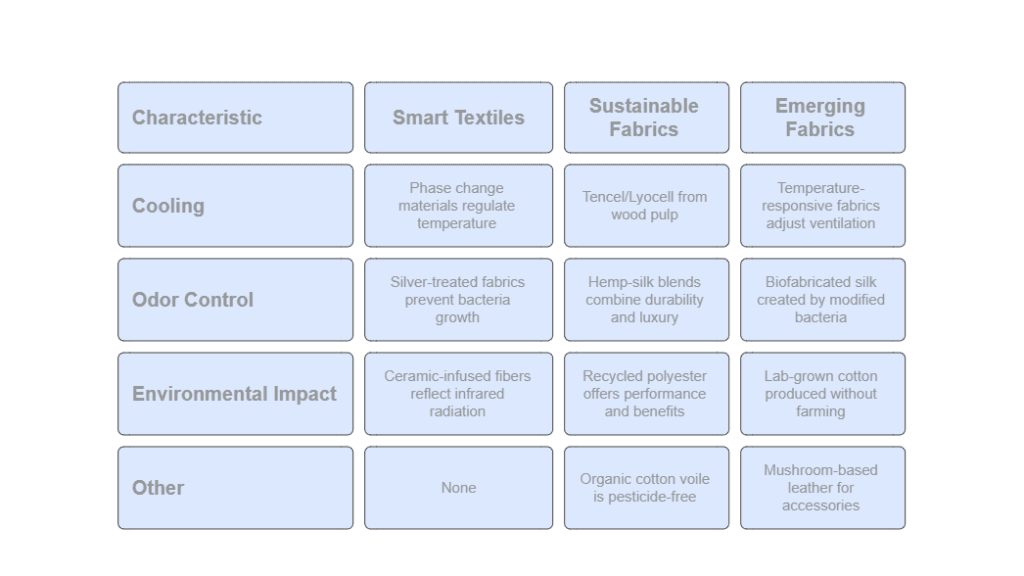
The textile industry continues developing new materials specifically for hot weather comfort. Understanding current innovations helps you make informed choices about emerging fabric technologies.
Smart Textiles and Cooling Technology
Phase change materials (PCMs) actively regulate temperature by absorbing excess body heat and releasing it when you cool down. These materials are incorporated into high-end athletic wear and bedding.
Ceramic-infused fibers reflect infrared radiation away from your body, creating a cooling effect. Brands are incorporating these particles into cotton and polyester blends for enhanced cooling.
Silver-treated fabrics provide antimicrobial properties that prevent odor-causing bacteria growth. This technology is particularly useful for people who sweat heavily or wear clothes multiple times between washings.
Sustainable Fabric Innovations
What is the Best Lining Fabric for Hot Weather?
Silk, cotton voile, or cupro (a type of rayon) make the best linings for hot weather. These materials breathe well and don’t add bulk. Avoid polyester linings in summer garments as they trap heat and moisture. New sustainable options include Tencel/Lyocell made from sustainably sourced wood pulp, hemp-silk blends combining durability with luxury feel, recycled polyester with performance properties and environmental benefits, and organic cotton voile from pesticide-free cultivation.
Understanding the broader category of types of fabrics, both natural and synthetic, helps you make informed decisions about sustainable summer clothing choices.
Eco-Friendly Fabric Trends for 2025
- Regenerative cotton farming practices
- Closed-loop production systems
- Waterless dyeing technologies
- Biodegradable synthetic alternatives
For more on upcoming fabric trends, check our 2025 fabric trends guide.
Emerging Fabric Technologies
Lab-grown materials are beginning to enter the market including biofabricated silk created by genetically modified bacteria, lab-grown cotton produced without traditional farming, and mushroom-based leather alternatives for accessories and trim.
Adaptive textiles respond to environmental conditions through temperature-responsive fabrics that adjust ventilation, moisture-activated cooling systems, and UV-reactive materials that change protection levels.
Color and Pattern Considerations for Summer Fabrics

What clothes are good in hot weather? Color and pattern choices significantly impact how comfortable you feel in summer fabrics.
Heat-Reflecting Color Strategies
Best Colors for Hot Weather
- White and light colors: Reflect sunlight and heat
- Pastels: Provide some heat reflection while adding color
- Light gray: Hides sweat better than pure white
- Cool blues and greens: Psychologically cooling effect
Colors to Avoid in Extreme Heat
- Black and dark colors absorb heat
- Bright reds and oranges feel psychologically warmer
- Dark patterns on light backgrounds show sweat marks
Pattern Choices for Sweat Management
Sweat-Hiding Patterns
- Busy florals and geometric prints
- Heather and marled textures
- Vertical stripes (create slimming effect in humid weather)
- Abstract designs with varied tones
Fabric Patterns That Enhance Cooling
- Open weaves and eyelet details
- Perforated patterns
- Mesh inserts and panels
- Cut-out details that increase airflow
Regional Climate Adaptations
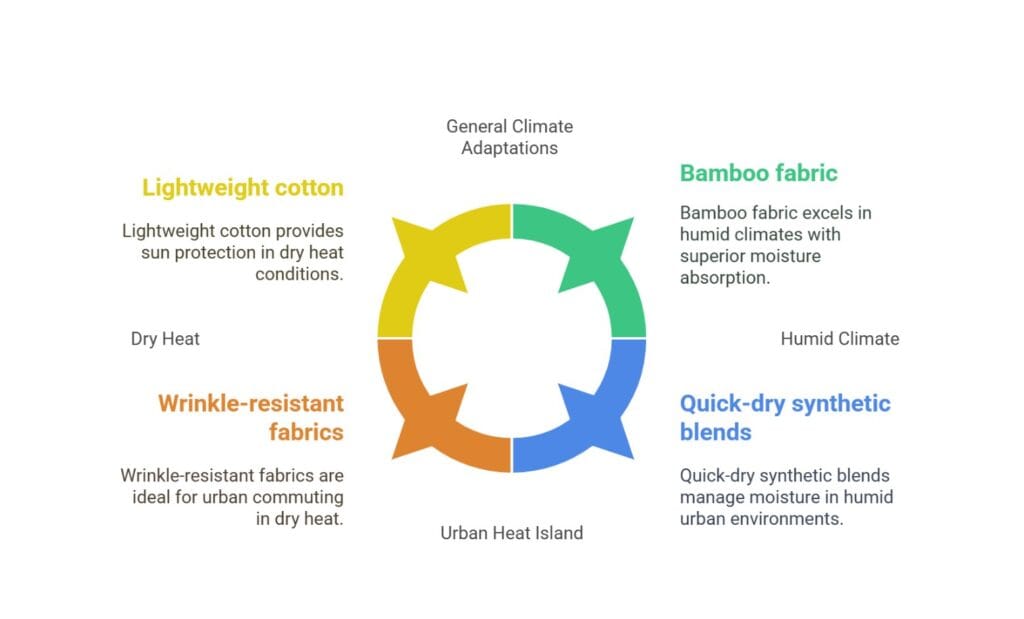
Different climates require specific fabric strategies. Understanding how humidity, temperature, and sun exposure affect fabric performance helps you choose appropriately for your location.
Dry Heat Strategies (Desert Climates)
Best Fabrics for Dry Heat
- Lightweight cotton with tight weave for sun protection
- Linen for maximum airflow
- Light-colored fabrics to reflect heat
- Longer sleeves in lightweight materials for UV protection
Desert Climate Considerations
- Protect skin from intense UV radiation
- Choose fabrics that won’t trap sand and dust
- Prioritize sun protection over pure breathability
- Layer lightweight pieces for temperature fluctuations
Humid Climate Solutions (Tropical and Coastal Areas)
Optimal Fabrics for Humidity
- Bamboo for superior moisture absorption
- Lightweight linen blends
- Quick-dry synthetic blends for athletic activities
- Open-weave cotton for maximum airflow
Humidity Management Strategies
- Prioritize moisture-wicking over heat reflection
- Choose loose-fitting styles to prevent clinging
- Avoid cotton in very humid conditions where it stays damp
- Consider antimicrobial treatments for extended wear
Urban Heat Island Considerations
City Summer Strategies
- Wrinkle-resistant fabrics for commuting
- Professional-looking materials that breathe well
- Quick-dry fabrics for walking and public transportation
- Layering pieces for air-conditioned buildings
Find the best fabrics for your specific climate
Use our Seasonal Fabric Quiz to get personalized recommendations based on your location and weather patterns.
Seasonal Shopping and Wardrobe Building
Building an effective summer wardrobe starts with understanding your specific needs. Smart shopping means investing in versatile pieces that work together.
Essential Summer Wardrobe Pieces by Fabric
Basic Tops
- Cotton jersey t-shirts (3-4 pieces)
- Linen button-down shirts (2-3 pieces)
- Silk or viscose blouses (2 pieces)
- Bamboo tank tops (2-3 pieces)
Bottoms
- Lightweight cotton pants (2 pairs)
- Linen trousers or palazzo pants (1-2 pairs)
- Cotton-blend shorts (2-3 pairs)
- Flowing skirts in viscose or cotton voile (2-3 pieces)
Dresses
- Cotton sundresses (2-3 pieces)
- Linen shirt dresses (1-2 pieces)
- Silk or rayon midi dresses (1-2 pieces)
Plan your perfect summer wardrobe
Our Summer Wardrobe Calculator helps you determine exactly how many pieces you need based on your climate, lifestyle, and laundry habits, plus provides realistic budget estimates.
Coordinating Fabrics and Textures
Mix textures for visual interest while maintaining comfort. Pair smooth cotton t-shirts with textured linen pants, flowing viscose tops with structured cotton bottoms, and soft bamboo pieces with crisp cotton accessories.
Layering Strategies
- Start with moisture-wicking base layers
- Add breathable middle layers for coverage
- Use lightweight outer layers for sun protection or air conditioning
Budget-Friendly Summer Fabric Choices
Get the Most Value
- Cotton: Versatile and affordable, holds up to frequent washing
- Viscose: Silk-like feel at a fraction of the cost
- Cotton-poly blends: Wrinkle resistance with better breathability than pure polyester
- Rayon: Budget-friendly alternative to expensive natural fibers
Investment Pieces Worth the Cost
- High-quality linen: Lasts for years and improves with age
- Merino wool: Versatile temperature regulation for various conditions
- Well-made silk pieces: For special occasions and professional wear
- Premium cotton: Superior weave quality means better performance
Shopping Tips
Smart Summer Fabric Shopping
- Check fabric content labels before buying
- Look for GSM under 180 for hot weather pieces
- Feel the fabric – it should feel light and airy
- Hold fabric up to light to check weave looseness
- Choose lighter colors for maximum heat reflection
- Test stretch and recovery on fitted pieces
- Read care labels to ensure maintenance fits your lifestyle
Calculate the true cost of your summer wardrobe
Use our Fabric Cost Calculator to compare quality versus price and determine the best value for your budget.
Frequently Asked Questions
What is the coolest fabric for summer?
Linen is the coolest fabric for summer, followed closely by bamboo. Linen’s loose weave creates maximum airflow and its hollow fibers naturally wick heat away from your body. Bamboo absorbs moisture better than cotton and dries quickly, making it ideal for humid climates.
What is the best fabric for summer?
The best fabric for summer depends on your specific needs. For overall comfort and versatility, lightweight cotton is hard to beat. For maximum cooling, choose linen. For moisture management in humidity, bamboo performs excellently. For professional wear, cotton poplin or Tencel work well.
What is the most breathable fabric?
Linen is the most breathable fabric, allowing more air circulation than any other common textile. Hemp comes in second place, followed by lightweight cotton gauze and bamboo fabric. These natural fibers have loose weaves and hollow or porous structures that promote airflow.
Is linen or silk better for summer?
Linen is generally better for summer due to superior breathability and durability. However, silk offers elegant draping and works well for dressier occasions. Choose linen for casual daily wear and hot, dry climates. Choose silk for special events, professional settings, or when you need wrinkle-resistant elegance.
Is 100% cotton good for hot weather?
Yes, 100% cotton is excellent for hot weather, especially in lightweight weaves. Cotton absorbs moisture well, feels soft against skin, and allows good airflow. However, linen and bamboo may feel cooler in extreme heat or high humidity. Choose cotton with GSM under 180 for best hot weather performance.
What fabrics are not good for summer?
Avoid 100% polyester, heavy denim, nylon without moisture-wicking treatment, acrylic, thick cotton twill, non-breathable synthetic blends, leather, faux leather, fleece, velvet, and heavy wool in summer. These fabrics trap heat, don’t breathe well, or are too heavy for hot weather comfort.
Does linen keep you cool?
Yes, linen keeps you very cool. It’s one of the most cooling fabrics available. Its natural structure allows heat to escape while permitting continuous airflow. The fabric doesn’t trap heat next to your skin like synthetic materials do. Many people report feeling 5-10 degrees cooler in linen compared to other fabrics.
Is viscose good for hot weather?
Yes, viscose is very good for hot weather. It’s highly breathable and absorbs more moisture than cotton while drying faster. The fabric drapes beautifully and feels silky against the skin, making it comfortable in humid conditions. However, viscose loses some strength when wet and requires gentle care.
What is the best fabric for wicking sweat?
Merino wool is the best natural fabric for wicking sweat, pulling moisture away 30% faster than cotton while naturally resisting odors. Among synthetics, treated polyester with moisture-wicking technology performs well for athletic activities. Bamboo and Tencel also excel at sweat management.
Is bamboo fabric good for summer?
Yes, bamboo fabric is excellent for summer. It absorbs 40% more water than cotton while drying faster, and its natural antibacterial properties reduce odors. The fabric feels cool to the touch and provides natural UV protection. Many people find bamboo even more comfortable than cotton for hot, humid weather.
Which fabric is cool for summer?
Multiple fabrics work well for summer cooling: linen (coolest overall), bamboo (best for humidity), cotton voile (lightweight and airy), silk (elegant and cool), Tencel (modern performance), and lightweight merino wool (temperature regulating). Choose based on your specific climate and activities.
Is silk breathable in hot weather?
Yes, silk is highly breathable in hot weather. Despite common misconceptions, silk wicks moisture away from the body and allows air to circulate freely. The smooth surface reflects heat while its porous structure allows moisture to escape, keeping you feeling fresh even on warm days.
Is 50% cotton 50% polyester good for summer?
A 50/50 cotton-polyester blend is acceptable for summer but not ideal. This blend offers wrinkle resistance and durability but sacrifices some breathability. You’ll stay cooler in 100% cotton or a blend with higher cotton content. The 50/50 blend works better for cooler summer evenings or air-conditioned environments.
What fabric does not show armpit sweat?
Dark colors (charcoal gray, navy, black), heather fabrics (marled textures), busy prints and patterns, and moisture-wicking athletic fabrics hide armpit sweat best. Textured fabrics like seersucker also camouflage wet spots better than smooth fabrics. Avoid light gray, which shows sweat worst of all colors.
Does nylon get hot in the summer?
Yes, nylon gets hot in summer because it traps heat next to your skin. The synthetic fibers don’t breathe well, and the fabric can feel clammy when you sweat. Nylon also tends to retain odors more than natural fabrics, making it a poor choice for hot weather unless specifically designed for athletic performance.
What is seersucker fabric?
Seersucker is a thin, puckered cotton fabric with a distinctive crinkled appearance created during the weaving process. The puckered sections stand away from smooth sections, creating natural air channels between the fabric and your skin. This unique structure makes seersucker one of the coolest fabrics for summer.
Is Tencel cool to wear?
Yes, Tencel is very cool to wear. This modern fabric made from wood pulp has excellent moisture management properties and feels cool to the touch. It absorbs 50% more moisture than cotton while maintaining breathability. Tencel is softer than cotton, drapes beautifully, and resists wrinkles.
What is the most breathable fabric for sleeping?
Cotton and linen are the most breathable fabrics for sleeping in summer. Egyptian cotton with a high thread count provides softness and breathability. Bamboo sheets also work excellently for hot sleepers due to superior moisture-wicking. Avoid polyester or synthetic blend sheets in summer as they trap heat.
Conclusion
Choosing the right fabrics for summer makes an enormous difference in your comfort and confidence during hot weather. The science is clear: natural fibers like linen, cotton, and bamboo consistently outperform synthetic materials for breathability and moisture management. However, modern textile innovations are creating exciting new options that combine the best of both worlds.
Key Takeaways for Your Summer Wardrobe
For maximum cooling: Choose linen for the hottest days, bamboo for humidity, and lightweight cotton for everyday comfort. These natural fibers provide unmatched airflow and moisture absorption. Linen remains the champion with its loose weave creating natural ventilation channels that keep you feeling 5-10 degrees cooler.
For active lifestyles: Merino wool offers the best combination of odor resistance and temperature regulation, pulling moisture away 30% faster than cotton. Moisture-wicking synthetic blends work well for intense athletic activities, but avoid them for casual summer wear where natural fibers perform better.
For professional settings: Lightweight cotton poplin, silk blends, and cotton-linen combinations maintain a polished appearance while keeping you cool. These fabrics resist wrinkles better than pure linen while providing good breathability, helping you look professional even in sweltering conditions.
For travel and versatility: Bamboo and viscose fabrics pack well, resist odors, and work in various climates. They’re also easy to care for and dry quickly when washed, making them ideal for vacation wardrobes where you need clothes that perform well without constant maintenance.
Budget-conscious shoppers should focus on quality cotton and viscose pieces that offer excellent value. These fabrics provide most of the benefits of expensive materials at a fraction of the cost, making it possible to build a complete summer wardrobe without breaking the bank.
Essential Guidelines to Remember
- Fabric weight matters as much as fiber type – look for GSM under 180 for hot weather
- Color affects heat absorption – light colors reflect heat while dark colors hide sweat
- Loose fits always perform better than tight clothing in summer
- Layer lightweight pieces rather than wearing heavy single garments
- Proper care extends fabric life and maintains cooling properties
- Natural fibers generally outperform synthetics for breathability
- Match fabric choice to your specific climate (dry heat vs humidity)
Sustainability Matters
Choose organic cotton, hemp, and Tencel when possible. These materials offer excellent performance while reducing environmental impact. The textile industry is rapidly developing eco-friendly alternatives that don’t compromise on comfort. By selecting sustainable fabrics, you’re investing in both your comfort and the planet’s future.
Looking Forward
The future of summer fabrics looks bright, with new technologies creating materials that actively cool your body while remaining environmentally responsible. Phase change materials, ceramic-infused fibers, and bio-fabricated textiles are revolutionizing how we stay comfortable in hot weather.
Whether you’re building a professional wardrobe, planning vacation outfits, or simply trying to survive another hot summer, understanding fabric properties empowers you to make choices that keep you comfortable, confident, and cool. Start with versatile basics in proven materials like cotton and linen, then experiment with innovative fabrics as your budget allows.
Your investment in quality summer fabrics pays dividends in comfort, durability, and style. The right fabric isn’t just about staying cool – it’s about feeling confident and comfortable so you can focus on enjoying your summer rather than battling the heat.
Take Action Now
Use the interactive tools mentioned throughout this guide to make data-driven decisions about your summer wardrobe. Our fabric comparison tool, wardrobe calculator, and virtual fabric feel guide take the guesswork out of fabric selection.
Remember: the best summer fabric is the one that works for your specific needs, climate, and lifestyle. Use this guide as your foundation, but don’t be afraid to try new materials and combinations to find your perfect summer wardrobe formula. With the right fabric knowledge and practical tools, summer heat becomes manageable rather than miserable.
Additional Resources
For more detailed information on specific topics covered in this guide, explore these external resources:
- Correlation of Air Permeability to Other Breathability Parameters of Textiles – National Institutes of Health research on fabric breathability and moisture vapor permeability
- Performance Characteristics of Waterproof Breathable Fabrics – Scientific research on fabric performance in various atmospheric conditions
- Fabric Breathability: A Scientific Approach – Technical guide to understanding fabric air circulation and moisture management
Stay informed about the latest fabric innovations and summer fashion trends by exploring our 2025 fashion forecast and fabric trends guide.

